|
History of Golden Age Breweries,
Inc.
(1933-1948)
When state-wide Prohibition hit Washington in 1916, most
breweries shut down, but a few struggled to stay in business by making soft
drinks and/or near-beer. Those who remained operational were in a position to
rapidly resume brewing real beer when Prohibition was repealed, but there were
not enough of them to meet the huge demand. Consequently investing in the
brewing business was a sure thing.
One of the Spokane breweries to close was the Shade Brewery. Its equipment had been
stripped and shipped to Canada. The building had remained abandoned for 17 years,
but it was still sound and was of great interest to would-be investors.
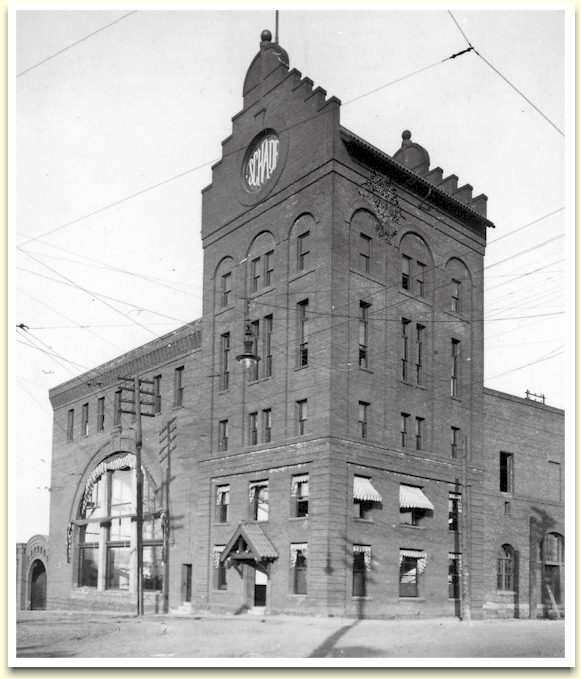
Schade Brewery ca.1903
In the Fall of 1933, a group of local venture capitalists established a corporation with express
purpose of purchasing unspecified investment property. On 21 November, it was announced that Mutual Realty
had purchased the Shade Brewery property, and on 10 December, 1933, Mutual Realty, Inc. became Golden Age Breweries, Inc.
One of the Mutual Realty group was Morris
Rosauer, the general manager of Spokane Brewing & Malting, who
had no doubt been enticed with profit sharing and stock options to
"jump ship". It
was an offer he couldn't refuse. So on December 1st, nine days prior
to the announcement of the purchase of the Shade Brewery, Morris left
Spokane B&M to become vice-president and general manager of the
Golden Age Brewery.
Morris had to now oversee a complete installation of a new plant,
which was to be completely state-of-the-art equipment. In April of 1934, he announced that the
Brewery would be ready to market more than 10,000 barrels of three-month aged Golden Age beer by June 10th. At that time their output was 300 barrels per day.
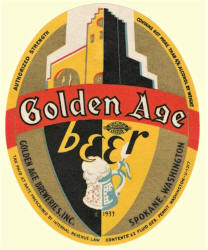 He almost made it. Sales of "Golden Age Beer" began on June 15, 1934, and it was available either on draught (draft), or in 22 ounce bottles.
This was a popular size used prior to Prohibition, and many of Washington's brewers¹ used this bottle.
He almost made it. Sales of "Golden Age Beer" began on June 15, 1934, and it was available either on draught (draft), or in 22 ounce bottles.
This was a popular size used prior to Prohibition, and many of Washington's brewers¹ used this bottle.
This label (copyright 1933) was on the first bottles - click to enlarge.
The label is unique in that the top half of the design is a stylized representation of the brewery's distinctive architecture.
In April of 1936 they simplified the design and made it the Brewery's logo - as
shown at the top of the page.
In an August of '34 newspaper ad Golden Age beer was purported to cause "no headaches".
This may not have been the case since this claim did not appear in future ads.
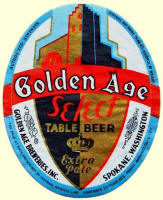 Sales were excellent for all of their beer and in November, just five months after their initial release,
they introduced Golden Age "Select, Extra Pale - table beer", also in the 22 oz. bottle.
Ads hyping the new product claimed it to be "non-fattening". Again, this claim was dropped in subsequent ads.
Sales were excellent for all of their beer and in November, just five months after their initial release,
they introduced Golden Age "Select, Extra Pale - table beer", also in the 22 oz. bottle.
Ads hyping the new product claimed it to be "non-fattening". Again, this claim was dropped in subsequent ads.
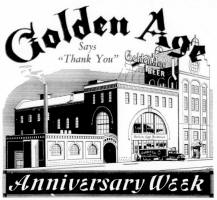 Sales
continued to exceed expectations, and they struggled to meet the
demand. Consequently, just a year later expenditures were allocated to double the plant's output. Sales
continued to exceed expectations, and they struggled to meet the
demand. Consequently, just a year later expenditures were allocated to double the plant's output.
In June of '35,
a half-page newspaper ad congratulated the Brewery on its one year anniversary, and
it included this art work - click to enlarge.
A month later the Brewery reintroduced the pre-Prohibition practice
of taking draft beer home from the saloon in a covered
pail called a "growler". But instead of a pail they accommodated this practice by
offering 22 oz. bottles of unpasteurized draft beer.
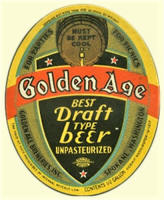 The label carried this warning: "Must be kept cool / UNPASTEURIZED". Since less than 25%
of households had refrigerators, and ice boxes weren't high capacity,
it's clear that most didn't follow the label's instructions and the
beer spoiled. Consequently, the brewery discontinued their unpasteurized
beer and began offering a pasteurized product instead. Handling
instructions were no longer needed! The label carried this warning: "Must be kept cool / UNPASTEURIZED". Since less than 25%
of households had refrigerators, and ice boxes weren't high capacity,
it's clear that most didn't follow the label's instructions and the
beer spoiled. Consequently, the brewery discontinued their unpasteurized
beer and began offering a pasteurized product instead. Handling
instructions were no longer needed!
Most of the NW breweries also attempted to market half-gallon
jugs of unpasteurized beer. All of them were unsuccessful and they returned
to pasteurizing their product.
 Again showing a flare for marketing Morris offered the
now pasteurized draft beer in half gallon jugs, but not ordinary jugs.
These were specially made in in the form of a barrel with an oval flat spot on the back for the label.
Unlike the 22 oz. bottles, these required a deposit to insure that they were returned
so they could be refilled.
Unfortunately, they were greatly admired and usually not returned. So this distinctive container was retired in favor of a plain,
and less expensive, half gallon jug.
The only other brewery to use an embossed figural jug was the Globe Brewing Co. of San Francisco. Again showing a flare for marketing Morris offered the
now pasteurized draft beer in half gallon jugs, but not ordinary jugs.
These were specially made in in the form of a barrel with an oval flat spot on the back for the label.
Unlike the 22 oz. bottles, these required a deposit to insure that they were returned
so they could be refilled.
Unfortunately, they were greatly admired and usually not returned. So this distinctive container was retired in favor of a plain,
and less expensive, half gallon jug.
The only other brewery to use an embossed figural jug was the Globe Brewing Co. of San Francisco.
With the expectation that Prohibition would soon be over, the can manufactures sped up their development of a container suitable for beer.
By Jan. of 1935, they had a product that required no deposit or return, was cheaper to ship, with no washing needed, and unbreakable.
Meanwhile, knowing that beer cans presented a direct threat, the bottle manufactures designed a
new product as an alternative.
It was called the "stubby" and was also a "one-way", compact, container
and had no metallic taste - a problem for early cans. The stubby was available seven months after the can, in Aug. of 1935, and was an immediate success
for bottle makers. It was soon followed by
another squat bottle called a "steinie" which had a different style neck.
 Rather than undertaking the expense and time to install a canning line, Morris chose to adopt the 11 oz. "steinie" as a container for his new release. In April
of 1936, Golden Age "Select Beer" with a new label, and smaller bottle, was on sale. Ads announcing the new bottles
stated: "They require no lacquer, wax or other foreign substance as a protective lining -
for nothing is so impervious to chemical reactions of beer as glass...the traditional container for beer"
- and added: "Beer Keeps Best in Bottles." The new label now displays the modernized logo mentioned above.
Rather than undertaking the expense and time to install a canning line, Morris chose to adopt the 11 oz. "steinie" as a container for his new release. In April
of 1936, Golden Age "Select Beer" with a new label, and smaller bottle, was on sale. Ads announcing the new bottles
stated: "They require no lacquer, wax or other foreign substance as a protective lining -
for nothing is so impervious to chemical reactions of beer as glass...the traditional container for beer"
- and added: "Beer Keeps Best in Bottles." The new label now displays the modernized logo mentioned above.

The following month, in May of '36, the Brewery introduced a
new brand, "Royal Select" in a new 11 ounce, clear, long neck bottle.
The ad copy described it as a streamlined champagne type bottle, and
the copy read: "The beer with the sparkle and tang of rare old
Champagne." The ribbon on the neck is similar to that of Pabst's
Blue Ribbon bottles, and the shape of the bottle is the same as that
used by Miller for their High Life Beer, whose slogan was "the
Champagne of bottled Beer". Just a coincidence?
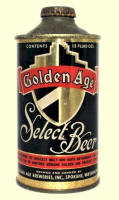 Once more, Morris was quick to grasp marketing trends, and on November
1st of 1936, he introduced Golden Age "Select Beer"
in a cap-sealed can², made by the Continental Can Co. His was the
first brewery in the region (the Inland Empire) to offer canned
beer. The statement that "Beer Keeps Best in Bottles" strangely
disappeared from the Brewery's advertising.
Once more, Morris was quick to grasp marketing trends, and on November
1st of 1936, he introduced Golden Age "Select Beer"
in a cap-sealed can², made by the Continental Can Co. His was the
first brewery in the region (the Inland Empire) to offer canned
beer. The statement that "Beer Keeps Best in Bottles" strangely
disappeared from the Brewery's advertising.
In May of '37, in a news article Morris revealed that $100,000 was to be spent to increase the plant's annual output to 160,000 barrels, and
to add 36 aging tanks. In June they installed a railroad spur which
then enabled them to initially ship 10 carloads of beer to new
markets, including California and parts of Montana.
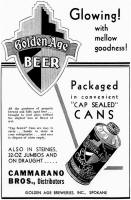 Then in
August it was reported that one million beer cans had been placed on
order, an amount requiring 18 carloads, half of which were 32 oz.
cans. The larger cans required the installation of
special equipment which cost $5,000 (which would be equivalent to over $100,000 today). Then in
August it was reported that one million beer cans had been placed on
order, an amount requiring 18 carloads, half of which were 32 oz.
cans. The larger cans required the installation of
special equipment which cost $5,000 (which would be equivalent to over $100,000 today).
That November of '37, exactly a year after the Brewery introduced canned
beer in the 12 oz. can, Golden Age was the first brewery in
Washington State to offer their beer in a quart size, cap-sealed
(aka cone-top) can, as well as in quart sized bottles. The Crown, Cork and Seal Co. was the first to make the qt. size available.
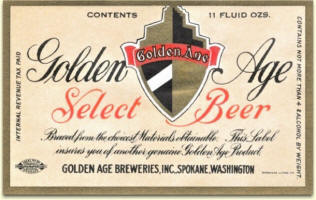 About the same time there was a change in labels. The "Select Beer" label on the steinie was changed
from a black label to an off-white label, with a slightly different layout. About the same time there was a change in labels. The "Select Beer" label on the steinie was changed
from a black label to an off-white label, with a slightly different layout.
1938 saw more changes to Golden Age's packaging. In April "Royal
Select" became available in the steinie, with the off-white label, as well as in the sleek "champagne" style
long-neck bottle. However, this streamlined shape was soon replaced by the traditional style,
long-neck bottle with shoulders.
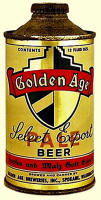 A month later, Morris introduced a new brew to the brewery's line-up.
"Select Export Pale" was available in 12 and 32 oz. cone-top cans or bottled in the steinie.
At the same time they started using the slogan
that would remain in use for the life of the Brewery: "Always
Right!" The only exception was for about a year during WW2 when
they used, "It's the Flavor".This would have annoyed the Olympia
Brewing Co. who's slogan was, "It's the Water". They may have filed
a complaint since Golden Age dropped it. A month later, Morris introduced a new brew to the brewery's line-up.
"Select Export Pale" was available in 12 and 32 oz. cone-top cans or bottled in the steinie.
At the same time they started using the slogan
that would remain in use for the life of the Brewery: "Always
Right!" The only exception was for about a year during WW2 when
they used, "It's the Flavor".This would have annoyed the Olympia
Brewing Co. who's slogan was, "It's the Water". They may have filed
a complaint since Golden Age dropped it.
However "Select Export Pale" didn't resonate with consumers and the
brand was gone by
the end of the following year. Also gone was the German slogan on
the can's red band - "Hopfen und Malz Gott erhalts" which means,
Hops and malt - may God preserve. This slogan was also on the 1938
version of the 12 oz., black, "Select Beer" can. This was no doubt dropped due
to the anti-German sentiment from the war in Europe.
1939 saw continued growth and Golden Age now had distributors in
California and Hawaii. The Brewery also purchased a fleet of art deco,
refrigerated, delivery trucks for local accounts, and two aluminum
bodied, 13 ton trucks for long distance delivery through four
northwest states.
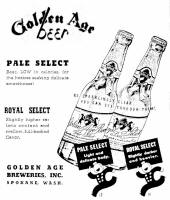 1940 opened in January with a new brew, "Pale Select".
Gone was the brand with the obscure word jumble of "Select Export
Pale". This new product was touted as a "light and delicate, low
calorie beer", and companion to the other "Select" brand in the
line-up, "Royal Select" - which was "darker and slightly heavier".
1940 opened in January with a new brew, "Pale Select".
Gone was the brand with the obscure word jumble of "Select Export
Pale". This new product was touted as a "light and delicate, low
calorie beer", and companion to the other "Select" brand in the
line-up, "Royal Select" - which was "darker and slightly heavier".
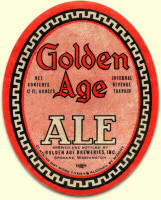 March of '40 saw the first shipment to Alaska, and by this time
bottled goods had overtaken kegged beer. Then late in 1940, a new
product was added to the brewery's line-up. Drawing on his early training on English style ales while in London, Morris introduced
his "Golden Age Ale" that December.
He formulated his "London Style" ale in both 4.5% and 6.5% strengths. Ale
was a more popular drink in the East, but like Bock beer, it was
expected to be included in a brewery's line-up. The brand lasted for at least five years,
but strangely he didn't produce another top-fermenting ale for the rest of his career.
March of '40 saw the first shipment to Alaska, and by this time
bottled goods had overtaken kegged beer. Then late in 1940, a new
product was added to the brewery's line-up. Drawing on his early training on English style ales while in London, Morris introduced
his "Golden Age Ale" that December.
He formulated his "London Style" ale in both 4.5% and 6.5% strengths. Ale
was a more popular drink in the East, but like Bock beer, it was
expected to be included in a brewery's line-up. The brand lasted for at least five years,
but strangely he didn't produce another top-fermenting ale for the rest of his career.
1941 would become a pivotal year for the Golden Age Brewery as well as all U.S. breweries.
In March the Brewery's board of directors chose a new president for the company, and just 17 days later Morrris Rosauer tendered his resignation.
The close timing of these two events would suggest that they were
related. It would be well over a year before Morris was once again
in charge of a brewery - the East Idaho Brewery of Pocatello.
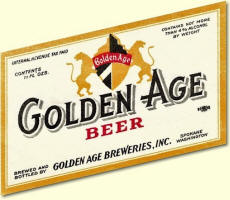 1941
also saw Golden Age making some packaging changes. They dropped 1941
also saw Golden Age making some packaging changes. They dropped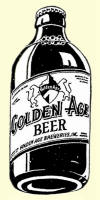 the
"steinie" in favor of the other 11 oz., squat type bottle - the "stubby". The
labels were also updated by switching the "Golden Age" font from
script to block letters. the
"steinie" in favor of the other 11 oz., squat type bottle - the "stubby". The
labels were also updated by switching the "Golden Age" font from
script to block letters.
In mid-year the plant manager announced plans for a major expansion
program which he described "as among the most important since the
establishment of the brewery in 1934."
But the most significant event for 1941 was America's entry into
WW2.
January of '42 saw the finish of the expansion project which included the installation of a huge new pasteurizer for the bottling plant
that had a capacity of 140 pint bottles per minute.
The size of the machine required a car of 80,000 pounds capacity to move it from St. Louis to Spokane,
with a total weight of 39 tons. It was reputedly the first installation of its kind in the northwest,
and was used to insure the keeping quality of bottled beer.
A new bottling plant was also installed which had a capacity of 75,000 bottles a day.
Also a new heavy duty bottle filler was added, that provided for the expulsion of all air from the bottle before it's filled to insure no oxygen is left.
Sadly, the increased capacity these improvements provided would never be fully utilized.
With the beginning of the war, and rationing of vital brewing
materials, the Brewery's output of beer was reduced, yet the demand
for beer was increased since Eastern breweries withdrew from western
markets. Now beer was only available on draft or in bottles since
cans were to be used only for the military. Also, bottle caps were
in short supply prompting ads urging the purchase of quarts rather
than 11 oz. bottles in order to reduce the number of caps needed.
In July of '43 Golden Age received an order from the armed services to allocate 15% of the brewery's output for the troops, and was told that the percentage may increase.
Not all of the beer for the military was shipped overseas, but the cans that did, utilized khaki
colored (aka olive-drab) cans⁴.
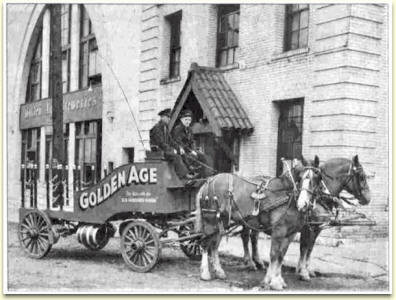
For the duration of the war, and its aftermath, breweries were hampered by a manpower shortage, as well as rationing of brewing ingredients and material.
Compounding this was the rationing of gasoline and rubber for tubes and tires. In response, Golden Age looked to past practices for a solution - a horse-drawn delivery wagon.
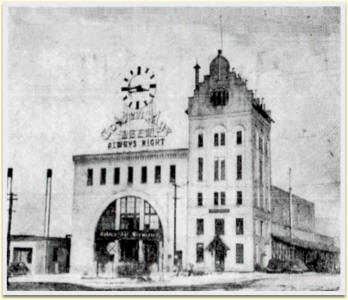 While
WWII ended in 1945 (May in Europe and Aug. in Japan) shortages
continued well after the war. In March of '46 the president ordered
breweries production be limited to 70% of their previous year's
output, but by December of '46 everything was looking bright and the
company added their slogan, "Always Right" to the massive 48 ft.
tall sign on the top of the brewery. While
WWII ended in 1945 (May in Europe and Aug. in Japan) shortages
continued well after the war. In March of '46 the president ordered
breweries production be limited to 70% of their previous year's
output, but by December of '46 everything was looking bright and the
company added their slogan, "Always Right" to the massive 48 ft.
tall sign on the top of the brewery.
By March of 1947 conditions had improved enough that Golden Age announced a brew-house upgrade with a new mash tub and a 170 barrel brew kettle,
but worried that the continued bottle shortage might prevent full-scale production.
Two months later, the Brewery introduced a new brand and a completely new look for the label. Golden Age Premium was available in a quart bottle,
or the 11 oz. stubby. From the red label it can be seen that with the Spring Bock season all that's required is to
add "Bock" and remove "Premium" from the regular label.
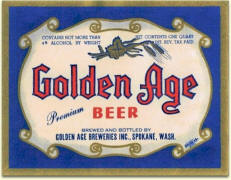 |
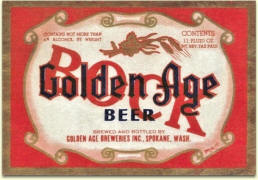 |
| 32 oz. label |
11 oz. label |
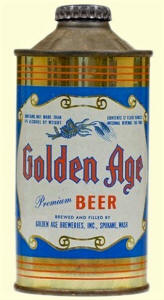 Then in August of 1947, regulations prohibiting the use
of the beer can for civilian use had also been terminated. This
relieved the worries over bottle shortages now that cans could be
filled again. Golden Age had never used the flat top steel can, and
didn't start now. They resumed using the cone-top,
but now chose Crown, Cork and Seal's version. Then in August of 1947, regulations prohibiting the use
of the beer can for civilian use had also been terminated. This
relieved the worries over bottle shortages now that cans could be
filled again. Golden Age had never used the flat top steel can, and
didn't start now. They resumed using the cone-top,
but now chose Crown, Cork and Seal's version.
The cans used the identical design as the bottle labels, including the colors, but they must have
produced fewer of the red version (or they were issued later) since fewer of them have survived.
However, none of the new cans would be around for long. On February 6th, 1948,
Golden Age Brewing Company, Inc. was purchased by Spokane's Bohemian Breweries for $240,000. At the time of the purchase, Bohemian's president, Edward Theis, explained their action:
"Our reason for purchasing the Golden Age
plant at this time is that Bohemian Club beer
sales have increased to a point where we are
now running our present brewery through out
the winter months almost to capacity.
Knowing that we could not possibly meet the
much greater demand that will naturally come
with warmer weather, and having already
expanded our brewing facilities in both
Spokane and Boise, Idaho, as much as our
present locations will permit, we felt it
imperative that we acquire the much needed
brewing facilities that are available in this
new plant. The move will enable us to
increase demand by late spring.
Bohemian Club is now sold exclusively
through out Idaho, Washington and Oregon,
but has been unable to accept
distributorships in many other territories
where it has been asked because there is
no way of further increasing plant capacity at
the present locations.
The combined capacity of the Boise plant
and the two Spokane plants of Bohemian
Breweries, Inc, will be approximately 350,000
barrels yearly. It is expected that employees
will number 260. The distribution area will
include areas of California, Montana and
Oregon, as well as Washington and Idaho."
If we are to believe their
stated reason for purchasing the Golden Age plant, it's curious that they shut it down in 1950. Perhaps the real reason for the purchase was to eliminate the competition,
and take over their accounts in Alaska, Hawaii, and Utah.
Prologue:
The old brewery still stands, and serves as a multi-purpose, commercial property
at, 528 E Spokane Falls Blvd., Spokane, WA 99202.
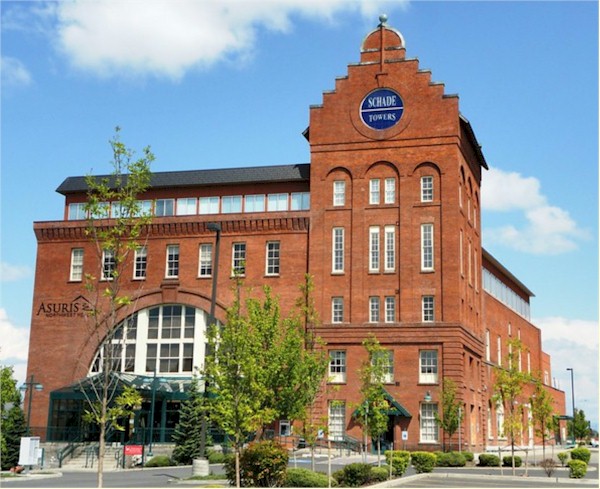
GOLDEN AGE BREWERIANA
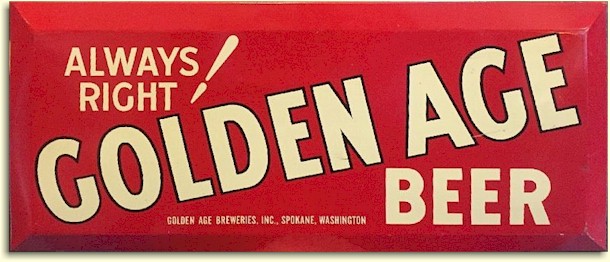
Tin-over-cardboard sign with 1938
slogan - Always Right!
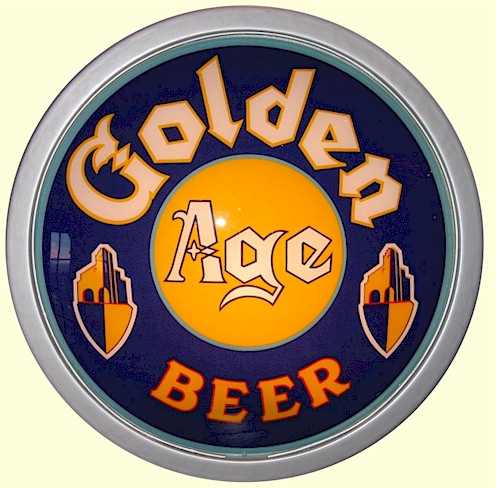
Lighted, reverse-on-glass painted,
convex glass lens -
17 ins. overall diameter.
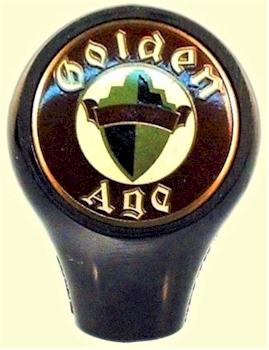 |
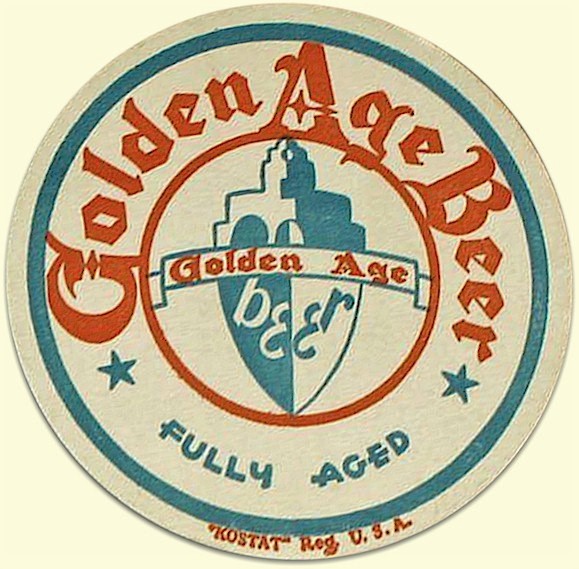 |
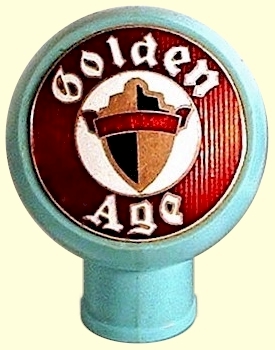 |
| early ball tap knob |
1st beer matt, or coaster |
later version knob |
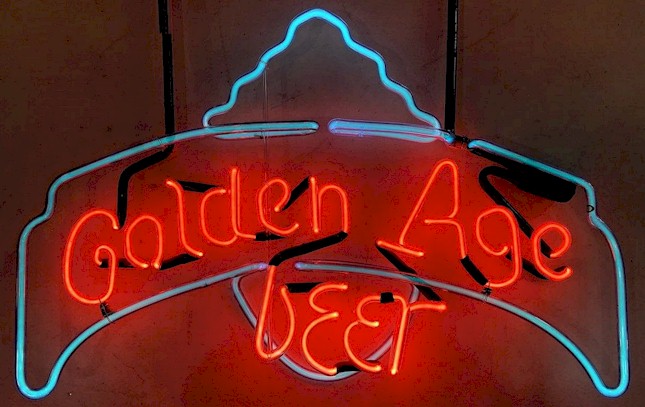 Golden Age neon sign
Golden Age neon sign
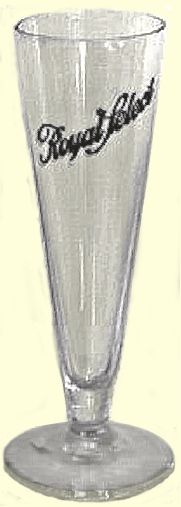
Royal Select pilsner glass
Does anyone have a better image?
FOOTNOTES: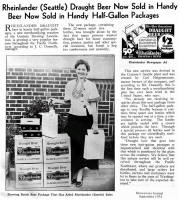
¹ The following are some of the breweries that
adopted the 22 oz. size bottles: Horluck,
Apex,
Hemrich,
Columbia, and Century's Rheinlander (at
right).
² Apex of Seattle was 1st in Washington State to offer the
cap-sealed can, followed by Golden Age and Bohemian, both of Spokane;
Mutual of
Ellensburg; and Martin's of Selah Springs.
³
Limitation Order L-103, dictating the size of beer bottles, was
rescinded after the war, on Nov. 1, 1946.
⁴
Olive-drab (OD) cans are highly valued by can collectors, and Golden
Age's OD cone-top can - even more so.
Article by
Gary Flynn

GOLDEN AGE COLLECTIBLES FOR SALE
 |
Half-gal. figural jug - Go to:
BOTTLES |
| |
|
ACKNOWLEDGEMENTS
-
Special thanks to Mike Slama for the image of his neon
sign.
-
And to Jeff Henry for the letterhead used as the history page header, as
well as the coaster.
For any comments, additions, or corrections please
contact me:
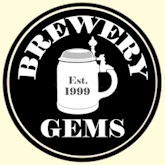 Copyright © 2022 by BreweryGems
~ All Rights Reserved.
|

